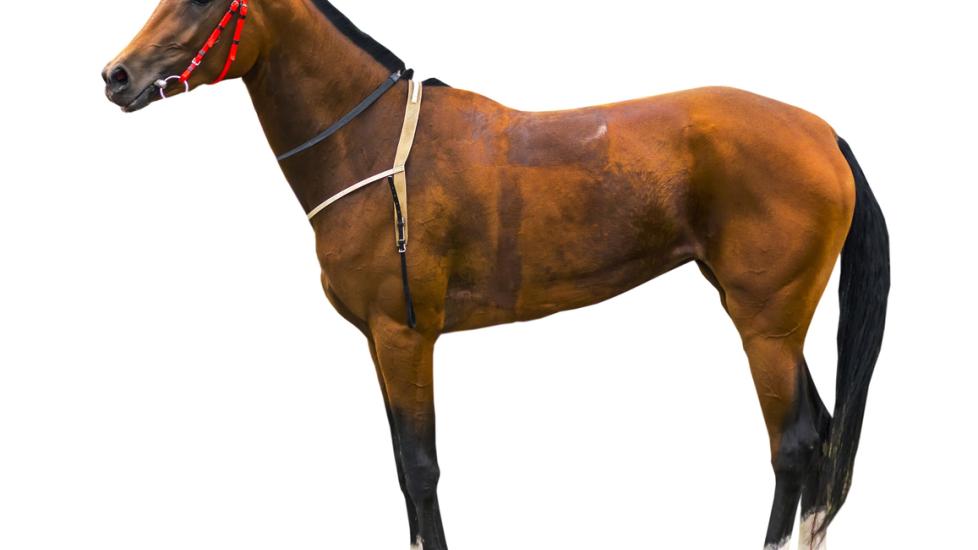Akhal-Teke
Reviewed for accuracy October 27, 2022.
The Akhal-Teke, otherwise known as the “Golden Horse” or "horse that sweats blood," is originally from the southern desert region of modern-day Turkmenistan and one of the most ancient horse breeds with a widely disputed history. It is best known for its shimmery coat and outstanding endurance.
Physical Characteristics
The Akhal-Teke is fine-boned and lean with a long, dipped back, a low-set tail, a narrow chest, and large feet. Its long head features large almond-shaped eyes and long muzzle, and its neck is angled rather than sloped. When it walks, it appears to be gliding. This is probably a result of its long legs and extended pasterns in the hind end that give it a very slight gait. Their hardiness, quick build, and endurance adapted the breed to be able to endure harsh desert conditions.
The breed stands between 14.3 hands (57 inches, 145 centimeters) and 16.3 hands (65 inches, 165 centimeters) high. The Akhal-Teke usually has white markings on its face and legs and can be found in different colors, including bay, black, chestnut, gray, and palomino. The most famous color is the pale, metallic buckskin—a gift from its Turkmen ancestors. Their often-metallic coats are due to more hollow hair shafts, which reflect the light in a shimmery manner. The myth that this breed sweats blood is due to the horses’ thin skin allowing blood vessels to be more visible during exercise.
History and Background
The Akhal-Teke is either a descendant or continuation of the fierce and much-valued ancient Turkomanhorse. The nomadic tribes, known as the "Teke," were the Akhal-Teke’s original breeders. They had peculiar ways of caring for their horses. For instance, they made their horses sweat out their extra fat so that they would remain lean. Otherwise, the horses wouldn’t have survived on the scant feed available.
The Turkmene breed was supposedly used by King Darius as a cavalry mount. Alexander the Great also used the same breed for his army; his father got the mounts from Fergana which is now known to be Turkmenistan. When the Romans came to the region, the Turkmene breed spread further and propagated, although it was heavily cross-bred to improve form and length. Parthian horses, for instance, are of Turkmenian descent. Parthian horses became so famous that the Chinese also wanted to possess the so-called "blood-sweating" horses; they made fine gifts for the Emperor.
Through the years, the Akhal-Teke breed has been carefully maintained by its breeders. In fact, it has remained so pure that its physical attributes closely mirror those of its ancestors.
Temperament
The Akhal-Teke is an emotional breed; often called “the horse of a single master,” these horses often will bond to just one person and will be difficult for anyone else to handle or train. They may be difficult to train at first as they can be stubborn and opinionated, but these loyal companions will gladly trudge through any long journey for their chosen partner once that connection is formed.
Care and Health
The Akhal-Teke shares some commonly acquired health issues with breeds it has helped developed. Similar to the Arabian horse breed, Akhal-Tekes have a higher prevalence for degenerative suspensory ligament desmitis (DSLD). This is a progressive disease that causes the breakdown of the suspensory branches in the fetlock area, particularly the hindlimbs. You may notice swollen and dropped fetlocks, or your horse shifting weight differently trying to get comfortable. While there is not currently a cure for this disease, there are some daily management changes such as therapeutic shoeing, anti-inflammatories, and controlled turnout that can help keep them comfortable should they develop it.
Akhal-Tekes may also be prone to cervical vertebral malformation (CVM or Wobbler’s Syndrome); this is a disease also seen in Thoroughbreds which can be traced back to this ancient breed. There is likely a genetic component to this process, but research is still ongoing in this area.
Featured Image: iStock.com/marlenka
Help us make PetMD better
Was this article helpful?
